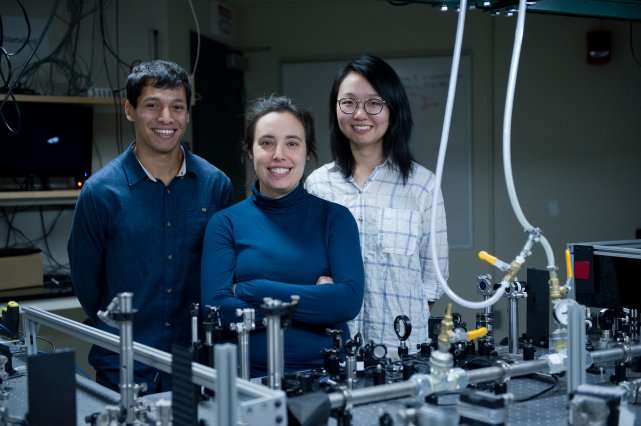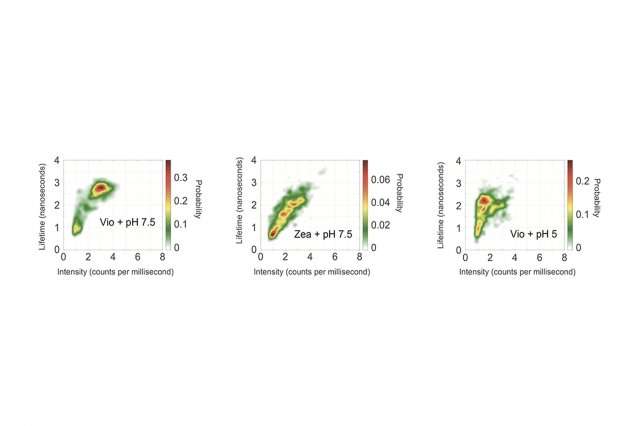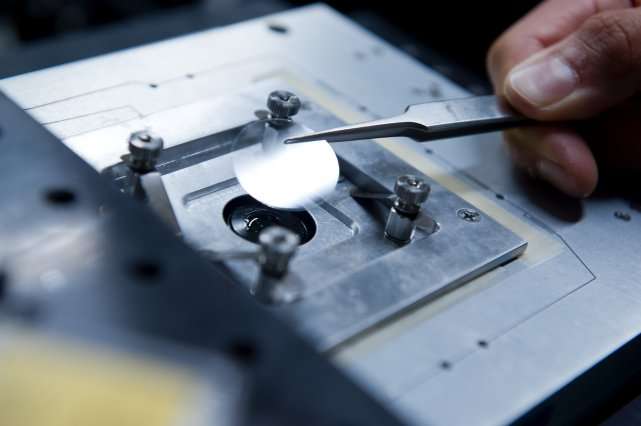Understanding how plants use sunlight

Plants rely on the energy in sunlight to produce the nutrients they need. But sometimes they absorb more energy than they can use, and that excess can damage critical proteins. To protect themselves, they convert the excess energy into heat and send it back out. Under some conditions, they may reject as much as 70 percent of all the solar energy they absorb.
"If plants didn't waste so much of the sun's energy unnecessarily, they could be producing more biomass," says Gabriela S. Schlau-Cohen, the Cabot Career Development Assistant Professor of Chemistry. Indeed, scientists estimate that algae could grow as much as 30 percent more material for use as biofuel. More importantly, the world could increase crop yields—a change needed to prevent the significant shortfall between agricultural output and demand for food expected by 2050.
The challenge has been to figure out exactly how the photoprotection system in plants works at the molecular level, in the first 250 picoseconds of the photosynthesis process. (A picosecond is a trillionth of a second.)
"If we could understand how absorbed energy is converted to heat, we might be able to rewire that process to optimize the overall production of biomass and crops," says Schlau-Cohen. "We could control that switch to make plants less hesitant to shut off the protection. They could still be protected to some extent, and even if a few individuals died, there'd be an increase in the productivity of the remaining population."
First steps of photosynthesis
Critical to the first steps of photosynthesis are proteins called light-harvesting complexes, or LHCs. When sunlight strikes a leaf, each photon (particle of light) delivers energy that excites an LHC. That excitation passes from one LHC to another until it reaches a so-called reaction center, where it drives chemical reactions that split water into oxygen gas, which is released, and positively charged particles called protons, which remain. The protons activate the production of an enzyme that drives the formation of energy-rich carbohydrates needed to fuel the plant's metabolism.

But in bright sunlight, protons may form more quickly than the enzyme can use them, and the accumulating protons signal that excess energy is being absorbed and may damage critical components of the plant's molecular machinery. So some plants have a special type of LHC—called a light-harvesting complex stress-related, or LHCSR—whose job is to intervene. If proton buildup indicates that too much sunlight is being harvested, the LHCSR flips the switch, and some of the energy is dissipated as heat.
It's a highly effective form of sunscreen for plants—but the LHCSR is reluctant to switch off that quenching setting. When the sun is shining brightly, the LHCSR has quenching turned on. When a passing cloud or flock of birds blocks the sun, it could switch it off and soak up all the available sunlight. But instead, the LHCSR leaves it on—just in case the sun suddenly comes back. As a result, plants reject a lot of energy that they could be using to build more plant material.
An evolutionary success
Much research has focused on the quenching mechanism that regulates the flow of energy within a leaf to prevent damage. Optimized by 3.5 billion years of evolution, its capabilities are impressive. First, it can deal with wildly varying energy inputs. In a single day, the sun's intensity can increase and decrease by a factor of 100 or even 1,000. And it can react to changes that occur slowly over time—say, at sunrise—and those that happen in just seconds, for example, due to a passing cloud.
Researchers agree that one key to quenching is a pigment within the LHCSR—called a carotenoid—that can take two forms: violaxanthin (Vio) and zeaxanthin (Zea). They've observed that LHCSR samples are dominated by Vio molecules under low-light conditions and Zea molecules under high-light conditions. Conversion from Vio to Zea would change various electronic properties of the carotenoids, which could explain the activation of quenching. However, it doesn't happen quickly enough to respond to a passing cloud. That type of fast change could be a direct response to the buildup of protons, which causes a difference in pH from one region of the LHCSR to another.
Clarifying those photoprotection mechanisms experimentally has proved difficult. Examining the behavior of samples containing thousands of proteins doesn't provide insights into the molecular-level behavior because various quenching mechanisms occur simultaneously and on different time scales—and in some cases, so quickly that they're difficult or impossible to observe experimentally.

Testing the behavior of proteins one at a time
Schlau-Cohen and her MIT chemistry colleagues, postdoc Toru Kondo and graduate student Wei Jia Chen, decided to take another tack. Focusing on the LHCSR found in green algae and moss, they examined what was different about the way that stress-related proteins rich in Vio and those rich in Zea respond to light—and they did it one protein at a time.
According to Schlau-Cohen, their approach was made possible by the work of her collaborator Roberto Bassi and his colleagues Alberta Pinnola and Luca Dall'Osto at the University of Verona, in Italy. In earlier research, they had figured out how to purify the individual proteins known to play key roles in quenching. They thus were able to provide samples of individual LHCSRs, some enriched with Vio carotenoids and some with Zea carotenoids.
To test the response to light exposure, Schlau-Cohen's team uses a laser to shine picosecond light pulses onto a single LHCSR. Using a highly sensitive microscope, they can then detect the fluorescence emitted in response. If the LHCSR is in quench-on mode, it will turn much of the incoming energy into heat and expel it. Little or no energy will be left to be reemitted as fluorescence. But if the LHCSR is in quench-off mode, all of the incoming light will come out as fluorescence.
"So we're not measuring the quenching directly," says Schlau-Cohen. "We're using decreases in fluorescence as a signature of quenching. As the fluorescence goes down, the quenching goes up."
Using that technique, the MIT researchers examined the two proposed quenching mechanisms: the conversion of Vio to Zea and a direct response to a high proton concentration.
To address the first mechanism, they characterized the response of the Vio-rich and Zea-rich LHCSRs to the pulsed laser light using two measures: the intensity of the fluorescence (based on how many photons they detect in one millisecond) and its lifetime (based on the arrival time of the individual photons).
More information: John I. Ogren et al. Impact of the lipid bilayer on energy transfer kinetics in the photosynthetic protein LH2, Chemical Science (2018). DOI: 10.1039/C7SC04814A
Toru Kondo et al. Single-molecule spectroscopy of LHCSR1 protein dynamics identifies two distinct states responsible for multi-timescale photosynthetic photoprotection, Nature Chemistry (2017). DOI: 10.1038/nchem.2818
Journal information: Chemical Science , Nature Chemistry
Provided by Massachusetts Institute of Technology
This story is republished courtesy of MIT News (web.mit.edu/newsoffice/), a popular site that covers news about MIT research, innovation and teaching.





















